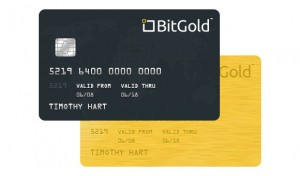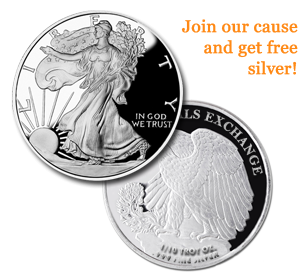Several Republican presidential candidates are floating the idea of returning to some form of a gold standard in the U.S., although none have gone into any great detail. So, how might a modern gold standard work?
 Bullion.Directory precious metals analysis 10 January, 2016
Bullion.Directory precious metals analysis 10 January, 2016
By Stefan Gleason
President of Sound Money Defense League
Don’t get me wrong, the long history of gold and silver being used as money going back to ancient times still matters. The basic principles behind sound money are timeless. Computer technology may make it easier than ever for central banks to create and manipulate digital fiat currency units, but easy doesn’t mean honest.
For better or worse, the digital economy is here to stay. It can be mostly for the better.There is nothing inherently dishonest about e-commerce or smartphone payments, and there is no reason why gold and silver can’t integrate into these and future systems.
In fact, the digital economy opens up a world of new opportunities for free-market alternative currencies to take hold. Alternative currencies and alternative banking backed ultimately by physical precious metals could represent the biggest threat to the Federal Reserve’s fiat currency regime.
Sound money advocates should be open to new applications of sound money principles. If we don’t, then our movement will be perceived as backward looking, out of touch, antiquated.
No matter how strongly we make the case for the merits of a currency backed by gold and silver, if people associate hard money exclusively with the past, they won’t perceive it as necessary or viable today.
Anyone who thinks that hard money requires the direct exchange of gold and silver coins throughout the economy is flat-out wrong. Even during the height of the U.S. gold standard system in the late 19th century, gold coins were more likely to be held as savings than to be spent directly in the economy. People more commonly paid for goods and services using silver coins or paper banknotes that were ultimately redeemable in gold.
Gold and Silver Can Easily Be Transacted Electronically
It’s possible to have a gold-based dollar in which all dollars are paper or digital certificates. As long as holders of dollars, in whatever form, have the ability to redeem them in gold on demand they are as good as gold.
It may well be that coins minted out of gold and silver never circulate widely as transactional currency again. They will continue to be hoarded as savings and stashed for use as money during emergencies should the need arise.
There are advantages to being able to exchange gold and silver value indirectly. If you’ve ever bought a bag ofpre-1965 90% silver coins, you know how silver coins can wear out over time.
It’s not a problem for investors who buy junk silver in bulk by its total silver content (wear being factored in). But it can be a problem in transactions when a heavily worn coin no longer holds its full intrinsic value. (The Coinage Act of 1792 defined a dollar as 371.25 grains of silver.)
 A debit card balance or a crypto-currency unit linked to a specific quantity of silver sitting in a secure vault solves that problem.
A debit card balance or a crypto-currency unit linked to a specific quantity of silver sitting in a secure vault solves that problem.
It also solves the problem of conventional account balances being intrinsically worthless. Bitcoin is ultimately backed by nothing, while bank account balances represent IOUs backed by nothing but the “full faith and credit” of the banks and U.S. government.
It is the notion of faith in a central authority that is antiquated. Central planning is the true “barbarous relic” of the 20th Century.
Today, virtually no professional economists believe a Soviet-style centrally planned economy works. Yet even though the Soviet Union collapsed more than two decades ago, its discredited central planning model persists to this day when it comes to currencies and interest rates. Central bankers are still being given the power to set interest rates for the whole economy, even though they have proven to be unskilled at best (and often downright inept) at forecasting economic cycles and preventing financial bubbles and busts.
Since 2009, the destructive Federal Reserve System has pumped trillions of fiat dollars into the banking system and Wall Street, effectuating a massive wealth transfer and putting the dollar’s global credibility at risk.
In their 2014 book Money: How the Destruction of the Dollar Threatens the Global Economy — and What We Can Do About It, authors Steve Forbes and Elizabeth Ames propose a modified gold standard. They write, “The twenty-first century gold standard would fix the dollar to gold at a particular price…. The Federal Reserve would use its tools, primarily open market operations, to keep the value of the dollar tied at that rate of gold.”
This hybrid monetary system would keep the central bankers in power but reinstitute gold as a constraint on their capacity to inflate. Even though the Forbes proposal is not an ideal free-market monetary system, it could serve as a model for reforming the existing system – and eventually transitioning to one that does away with the Federal Reserve altogether.
Ending the Fed could mean establishing a new gold and silver standard (perhaps through a Constitutional amendment that fixes the dollar’s value in terms of gold and/or silver).
Or a gold standard could be achieved by ending government’s legal tender monopoly entirely and letting free-market currencies take over (some of which may be redeemable in precious metals; others of which may not).
Electronic gold and silver payments using innovations like BitGold and the Gold Standard Society’s Digital Gold 2.0 may prove in the future that free-market hard money is viable for everyday transactions.
All it will then need is the right to compete directly with the U.S. dollar as legal tender.
This article was originally published hereBullion.Directory or anyone involved with Bullion.Directory will not accept any liability for loss or damage as a result of reliance on the information including data, quotes, charts and buy/sell signals contained within this website. Please be fully informed regarding the risks and costs associated with trading in precious metals. Bullion.Directory advises you to always consult with a qualified and registered specialist advisor before investing in precious metals.













 Material provided on the Bullion.Directory website is strictly for informational purposes only. The content is developed from sources believed to be providing accurate information. No information on this website is intended as investment, tax or legal advice and must not be relied upon as such. Please consult legal or tax professionals for specific information regarding your individual situation. Precious metals carry risk and investors requiring advice should always consult a properly qualified advisor. Bullion.Directory, it's staff or affiliates do not accept any liability for loss, damages, or loss of profit resulting from readers investment decisions.
Material provided on the Bullion.Directory website is strictly for informational purposes only. The content is developed from sources believed to be providing accurate information. No information on this website is intended as investment, tax or legal advice and must not be relied upon as such. Please consult legal or tax professionals for specific information regarding your individual situation. Precious metals carry risk and investors requiring advice should always consult a properly qualified advisor. Bullion.Directory, it's staff or affiliates do not accept any liability for loss, damages, or loss of profit resulting from readers investment decisions.

Leave a Reply